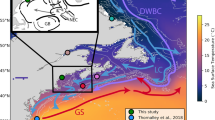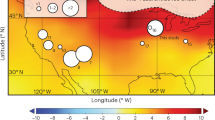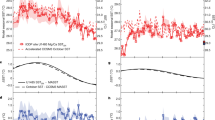Abstract
To determine the mechanisms governing the last deglaciation and the sequence of events that lead to deglaciation, it is important to obtain a temporal framework that applies to both continental and marine climate records. Radiocarbon dating has been widely used to derive calendar dates for marine sediments, but it rests on the assumption that the ‘apparent age’ of surface water (the age of surface water relative to the atmosphere) has remained constant over time1,2. Here we present new evidence for variation in the apparent age of surface water (or reservoir age) in the North Atlantic ocean north of 40° N over the past 20,000 years. In two cores we found apparent surface-water ages to be larger than those of today by 1,230 ± 600 and 1,940 ± 750 years at the end of the Heinrich 1 surge event (15,000 years BP) and by 820 ± 430 to 1,010 ± 340 years at the end of the Younger Dryas cold episode. During the warm Bølling–Allerød period, between these two periods of large reservoir ages, apparent surface-water ages were comparable to present values. Our results allow us to reconcile the chronologies from ice cores and the North Atlantic marine records over the entire deglaciation period. Moreover, the data imply that marine carbon dates from the North Atlantic north of 40° N will need to be corrected for these highly variable effects.
This is a preview of subscription content, access via your institution
Access options
Subscribe to this journal
Receive 51 print issues and online access
$199.00 per year
only $3.90 per issue
Buy this article
- Purchase on Springer Link
- Instant access to full article PDF
Prices may be subject to local taxes which are calculated during checkout



Similar content being viewed by others
References
Bard, E. et al. Retreat velocity of the North Atlantic polar front during the last deglaciation determined by 14C accelerator mass spectrometry. Nature 328, 791–794 (1987).
Voelker, A. et al. Correlation of marine 14C ages from the Nordic Seas with the GISP2 isotope record: Implications for 14C calibration beyond 25 ka BP. Radiocarbon 40, 517–534 (1998).
Stuiver, M. et al. INTCAL98 radiocarbon age calibration, 24,000-0 cal BP. Radiocarbon 40, 1041–1083 (1998).
Alley, R. B. et al. Abrupt increase in Greenland snow accumulation at the end of the Younger Dryas event. Nature 362, 527–529 (1993).
Bard, E. Correction of accelerator mass spectrometry 14C ages measured in planktonic foraminifera: paleoceanographic implications. Paleoceanography 3, 635–645 (1988).
Stuiver, M. & Braziunas, T. F. Sun, ocean, climate and atmospheric 14CO2: an evaluation of causal and spectral relationship. The Holocene 3, 289–305 (1993).
Bard, E. et al. The North Atlantic atmosphere-sea surface 14C gradient during the Younger Dryas climatic event. Earth Planet. Sci. Lett. 126, 275–287 (1994).
Austin, W. E. N., Bard, E., Hunt, J. B., Kroon, D. & Peacock, J. D. The 14C age of the Icelandic Vedde Ash: implications for Younger Dryas marine reservoir age corrections. Radiocarbon 37, 53–62 (1995).
Siani, G. Estimation de l'âge 14C du réservoir des eaux de surface de la mer Méditerranée pendant les derniers 18000 ans. Thesis, Univ. Paris-Sud (1999).
Sikes, E. L., Samson, C. R., Guilderson, T. P. & Howard, W. R. Old radiocarbon ages in the southwest Pacific Ocean during the last glacial period and deglaciation. Nature 405, 555–559 (2000).
Duplessy, J. C. et al. Changes in surface salinity of the North Atlantic Ocean during the last deglaciation. Nature 358, 485–487 (1992).
Labeyrie, L. et al. in Mechanisms of Global Climate Change at Millennial Time Scales, Geophysical Monograph Series 112 (eds Clark, P. & Webb, R. S.) 77–98 (American Geophysical Union, Washington, DC, 1999).
Stuiver, M. & Reimer, P. J. Extended 14C data base and revised CALIB 3.0 14C age calibration program. Radiocarbon 35, 215–230 (1993).
Bard, E., Arnold, M., Duprat, J., Moyes, J. & Duplessy, J. C. Reconstruction of the last deglaciation: deconvolved records of δ18O profiles, micropaleontological variations and accelerator mass spectrometric 14C dating. Clim. Dynam. 1, 101–112 (1987).
Johnsen, S. J. et al. The δ18O record along the Greenland Ice Core Project deep ice core and the problem of possible Eemian climatic instability. J. Geophys. Res. 102, 26397–26410 (1997).
Broecker, W., Bond, G., Klas, M., Clark, E. & MacManus, J. Origin of the northern Atlantic's Heinrich events. Clim. Dynam. 6, 265–273 (1992).
Boyle, E. A. Cadmium: chemical tracer deepwater paleoceanography. Paleoceanography 3, 471–489 (1988).
Labeyrie, L. D. et al. Changes in vertical structure of the North Atlantic Ocean between glacial and modern times. Quat. Sci. Rev. 11, 401–413 (1992).
Duplessy, J.-C. et al. Deepwater source variations during the last climatic cycle and their impact on the global deepwater circulation. Paleoceanography 3, 343–360 (1988).
Sarnthein, M. et al. Changes in east Atlantic deepwater circulation over the last 30,000 years: eight time slice reconstructions. Paleoceanography 9, 209–267 (1994).
Muscheler, R., Beer, J., Wagner, G. & Finkel, R. Changes in deep-water formation during the Younger Dryas event inferred from 10Be and 14C records. Nature 408, 567–570 (2000).
Vidal, L. et al. Evidence for changes in the North Atlantic Deep Water linked to meltwater surges during the Heinrich events. Earth Planet. Sci. Lett. 146, 13–26 (1997).
Mikolajewicz, U. A meltwater induced collapse of the conveyor belt thermohaline circulation and its influence on the distribution of Δ14C and δ18O in the oceans. Max Planck Inst. Rep. 189, 1–25 (1996).
Stocker, T. F. & Wright, D. G. Rapid changes in ocean circulation and atmospheric radiocarbon. Paleoceanography 11, 773–795 (1996).
Stocker, T. F. & Wright, D. G. The effect of a succession of ocean ventilation changes on 14C. Radiocarbon 40, 359–366 (1998).
Dokken, T. M. & Jansen, E. Rapid changes in the mechanism of ocean convection during the last glacial period. Nature 401, 458–461 (1999).
Waelbroeck, C. et al. Improving past sea surface temperature estimates based on planktonic fossil faunas. Paleoceanography 13, 272–283 (1998).
Malmgren, B., Kucera, M., Nyberg, J. & Waelbroeck, C. Comparison of available statistical and artificial neural network techniques for estimating past sea-surface temperatures from planktonic foraminifera census data. Palaeoceanography (in the press).
Bondevik, S., Birks, H. H., Gulliksen, S. & Mangerud, J. Late Weichselian marine 14C reservoir ages at the western coast of Norway. Quat. Res. 52, 104–114 (1999).
Labeyrie, L. et al. Surface and deep hydrology of the northern Atlantic Ocean during the last 150,000 years. Phil. Trans. R. Soc. Lond. 348, 255–264 (1995).
Acknowledgements
We thank E. Bard and G. Siani for discussions and comments. The data were acquired in collaboration with T. van Weering, J.-L. Turon, M. Labracherie and G. Auffret. We thank B. Lecoat and J. Tessier for processing the isotopic measurements. This study was supported by CNRS, CEA, INSU (PNEDC) and EU Environment Program.
Author information
Authors and Affiliations
Corresponding author
Rights and permissions
About this article
Cite this article
Waelbroeck, C., Duplessy, JC., Michel, E. et al. The timing of the last deglaciation in North Atlantic climate records. Nature 412, 724–727 (2001). https://doi.org/10.1038/35089060
Issue Date:
DOI: https://doi.org/10.1038/35089060
This article is cited by
-
Dynamic and thermodynamic influences on precipitation in Northeast Mexico on orbital to millennial timescales
Nature Communications (2023)
-
Freshwater forcing of the Atlantic Meridional Overturning Circulation revisited
Nature Climate Change (2022)
-
Millennial and centennial CO2 release from the Southern Ocean during the last deglaciation
Nature Geoscience (2022)
-
Eurasian Ice Sheet collapse was a major source of Meltwater Pulse 1A 14,600 years ago
Nature Geoscience (2020)
-
Deep-water circulation changes lead North Atlantic climate during deglaciation
Nature Communications (2019)
Comments
By submitting a comment you agree to abide by our Terms and Community Guidelines. If you find something abusive or that does not comply with our terms or guidelines please flag it as inappropriate.



